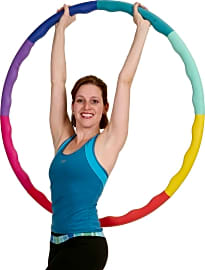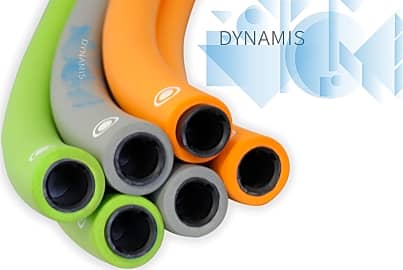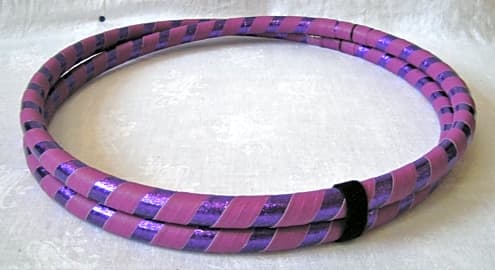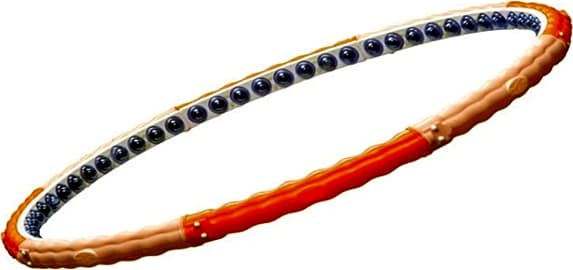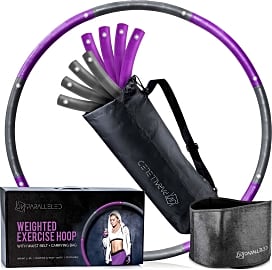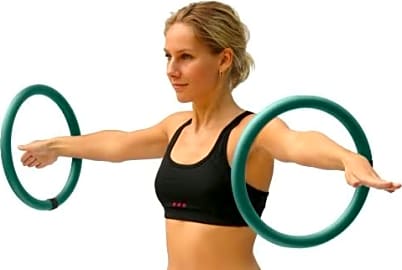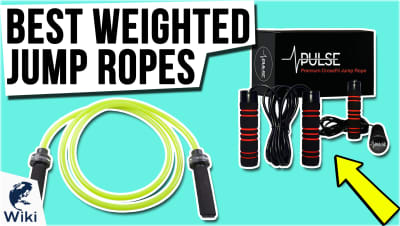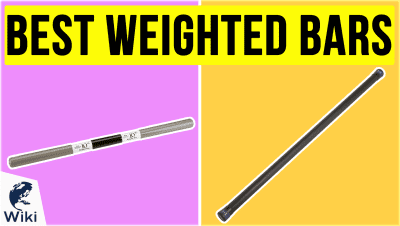The 10 Best Weighted Hula Hoops

This wiki has been updated 37 times since it was first published in January of 2016. If you're looking for a fun way to mix up your regular exercise routine, take one of these weighted hula hoops for a spin. They can help you trim your waist; improve your posture, coordination, and circulation; and give you a great cardiovascular workout. Just be sure to pick the right size and weight option for your body and fitness level, as these can cause bruising if used improperly. When users buy our independently chosen editorial picks, we may earn commissions to help fund the Wiki.
Editor's Notes
August 31, 2020:
Whether you're looking to break out of a fitness rut, or you are working hard to target your ab muscles, a weighted hula hoop can help you achieve your goals. We've kept a range of options, many of which come apart for easy storage with the rest of your at-home fitness equipment, from weighted jump ropes to exercise bands. Because getting used to one of these hoops can take some time, we still like the The Spinsterz Fitness and the Stamina Fitness 2.5-Pound for beginners. These shouldn't be uncomfortably heavy for most, although you'll want to take your time getting started. For those who already have some stamina and muscle strength built up, we kept the Health Hoop Passion Magnetic, which weighs in at 6 pounds. But we removed the Hydong Glow, even though the idea of a light-up hoop is a good one. Unfortunately, it just doesn't offer enough durability to make it worth the cost.
An interesting new addition at this time is the NGC-C 2-in-1. If you've tried hooping, and can't get one to stay up around your waist, this model might help. It is smaller than a traditional hoop, which allows it to stay up on its own. The design is such that it massages your waist while you're using it, but this could be too intense for some, so as with other models, go easy at first.
July 05, 2019:
Currently, we've opted for a selection of various weights from light to heavy, which should offer something for all fitness levels. For those who are new to hooping, we still like The Spinsterz Fitness, an America-made, high-quality option that comes in sizes for nearly everyone. You'll need some patience after it arrives, however, as it must sit for 12 hours before you put it together. If you skip this step, it may end up lopsided once it's assembled. There's also the Stamina Fitness 2.5-Pound; it's not too heavy and has foam padding to keep you comfortable for longer sessions. We decided to add the Hydong Glow, as well. Its relatively light weight and colorful LEDs may encourage those who are reluctant to exercise. Note that you can't control the colors — they flash randomly.
For those who are more advanced, we kept the Health Hoop Passion Magnetic. Although its claims to improve circulation with the integrated magnets seem specious, it is one of the heavier options you'll find, giving you a great workout. Some also find that the air pockets provide massaging action, loosening the lower back muscles. But this is not a good choice for beginners, so you'll need to work your way up to it.
Special Honors
Virfit Vhoop Smart Hula hooping has entered the 21st century with the Virfit Vhoop Smart, a battery-powered, Bluetooth model that lets you track the metrics of your workout via the smartphone app. It's neither cheap nor widely available, but for those who love data, it's an option to consider. vhoop.net
A Brief History Of The Hula Hoop
And in certain Native American tribes, the scared Hoop Dance was an important part of ritual observation, and one still preserved today.
Let us start our discussion of the hula hoop by clearing up two common misconceptions. First, the hula hoop was not invented in the 1950s; in fact, hoops have been used for ritual and recreation for centuries, if not millennia -- more to follow in that regard soon.
Second, the traditional Hawaiian Hula dance has nothing to do with the hula hoop; it was a part of both social and ritual performance long before the first contact between Westerners and the Polynesians who settled the islands. The modern hula hoop simply coopted the term based on ostensibly similar hip movements involved in Hula dancing and in keeping a hoop aloft by gyrating one's body.
Hoops used in a manner similar to the ubiquitous plastic hula hoop known today have not only been used for centuries, but in many different parts of the world, too. The use of hoops can be traced to Ancient Egypt, where they were often made out of dried grapevines or grasses, and they show up in the images adorning Ancient Grecian urns, as well.
In Medieval Europe, especially among the British Isles, hoop dancing was for a time wildly popular both as a play activity and as religious devotional practice. Those hoops were usually made of wood or metal. And in certain Native American tribes, the scared Hoop Dance was an important part of ritual observation, and one still preserved today. The Hoop Dance used a hoop to symbolize the endless circle of life.
The term hula hoop was likely brought back to the West by 19th century British sailors who had seen Polynesian natives doing their Hula dances. With hoop play again popular in Western Europe in the 1800s, the logical though apocryphal connection was made been hula dancing and hip hoop spinning, and the name stuck.
The modern hula hoop was first released in 1958, having been designed by a pair of men named Arthur Melin and Richard Knerr, who had the simple but wise idea to make the same type of hoop already widely used throughout history and around the world out of a lightweight plastic. The toy and a fad surrounding it took off, an hula hoops have been popular everywhere ever since.
Today, hula hoop use -- often called hooping -- is popular among adults and children alike, both as a play activity and for the challenges advanced hooping presents. Hula hoops can also be valuable exercise tools, great for cardio workouts and for core training. Thus the rising popularity of weighted hula hoops, which only add to the effort and excitement of hoop use.
Choosing The Right Weighted Hula Hoop
The first thing to consider when looking into getting a weighted hula hoop to augment your fitness routine is size; that is to say your size. The standard measurement of an adult hula hoop is 40 inches in diameter, and many weighted hula hoops are this size, as well.
The second consideration is to decide how heavy of a weighted hula hoop is right for you.
Many are also available in several sizes, and some weighted hula hoops can even be adjusted, as they come in sections that can be added or removed as needed. This makes for comfortable use of the same hoop by multiple people, which is especially convenient for a school or gym, or for the large family of hoopers.
The second consideration is to decide how heavy of a weighted hula hoop is right for you. Some weighted hoops weight just two pounds (or slightly under) while others weigh in at a hefty five pounds, which is more than enough to have your sweat production and calorie burning greatly elevated.
Next consider whether you want a smooth hoop or one with a contoured interior. The latter are easier to control, but can also be less comfortable to use. This is especially true if you plan to use your hoop not only around your waist for cardio exercise, but also for use around your ankles and wrists for leg and arm workouts, respectively. For a hoop that will see total body use, a smooth hoop might be the better idea.
Exercising Properly Means Exercising Caution
Before you commence any new exercise routine, you have to make sure you are physically up to the challenges that it will present. If you are not already physically fit, even an activity as seemingly benign as hula hooping can lead to injury if not undertaken with care, so ease into the practice using a regular (i.e. not weighted) hula hoop initially, letting your body get the hang of the motion and letting your lungs and heart ease into activity for several days or even a week or two.
Before you commence any new exercise routine, you have to make sure you are physically up to the challenges that it will present.
Also note that even the physically fit will often experience bruising and soreness for several days (or longer) when initially beginning to use a weighted hula hoop; this simply comes with the territory. Hula hoops with textured interiors will cause even more tenderness and bruising, but your body will adapt soon enough. Just don't overdo the use of a weighted hula hoop in the early days of its adoption, or you risk an actual injury.
Make sure you use your weighted hula hoop either outside or in a room with ample open space. It is far too easy to knock over nearby items or to stumble over your own feet when using a hula hoop, and a weighted hoop only increases the damage that can be done when the hoop bumps into something or someone, or else drops around your own ankles. Even with something as simple as hula hooping, safety always comes first.



